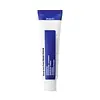What's inside
What's inside
 Key Ingredients
Key Ingredients

 Benefits
Benefits

 Concerns
Concerns

 Ingredients Side-by-side
Ingredients Side-by-side

Sea Water
HumectantDipropylene Glycol
HumectantGlycerin
HumectantWater
Skin ConditioningCaprylic/Capric Triglyceride
MaskingNiacinamide
SmoothingPhenyl Trimethicone
Skin ConditioningCetyl Ethylhexanoate
EmollientCetearyl Alcohol
Emollient1,2-Hexanediol
Skin ConditioningSodium Acrylate/Sodium Acryloyldimethyl Taurate Copolymer
Emulsion StabilisingButylene Glycol
HumectantSodium Hyaluronate
HumectantPanthenol
Skin ConditioningEcklonia Cava Extract
Skin ConditioningLaminaria Japonica Extract
Skin ProtectingCaulerpa Lentillifera Extract
Salicornia Herbacea Extract
Skin ConditioningAllantoin
Skin ConditioningMacadamia Ternifolia Seed Oil
EmollientAdenosine
Skin ConditioningSorbitan Stearate
EmulsifyingSorbitan Oleate
EmulsifyingIsohexadecane
EmollientPolysorbate 80
EmulsifyingGlyceryl Stearate Se
EmulsifyingCarbomer
Emulsion StabilisingArginine
MaskingCaprylyl Glycol
EmollientEthylhexylglycerin
Skin ConditioningDisodium EDTA
Sea Water, Dipropylene Glycol, Glycerin, Water, Caprylic/Capric Triglyceride, Niacinamide, Phenyl Trimethicone, Cetyl Ethylhexanoate, Cetearyl Alcohol, 1,2-Hexanediol, Sodium Acrylate/Sodium Acryloyldimethyl Taurate Copolymer, Butylene Glycol, Sodium Hyaluronate, Panthenol, Ecklonia Cava Extract, Laminaria Japonica Extract, Caulerpa Lentillifera Extract, Salicornia Herbacea Extract, Allantoin, Macadamia Ternifolia Seed Oil, Adenosine, Sorbitan Stearate, Sorbitan Oleate, Isohexadecane, Polysorbate 80, Glyceryl Stearate Se, Carbomer, Arginine, Caprylyl Glycol, Ethylhexylglycerin, Disodium EDTA
Water
Skin ConditioningGlycerin
HumectantCyclopentasiloxane
EmollientButylene Glycol
HumectantDimethicone
EmollientAlcohol Denat.
AntimicrobialPentylene Glycol
Skin ConditioningPEG/PPG/Polybutylene Glycol-8/5/3 Glycerin
HumectantAmmonium Acryloyldimethyltaurate/Vp Copolymer
Raffinose
Skin ConditioningCaprylyl Glycol
EmollientDimethiconol
EmollientParfum
MaskingAcrylates/C10-30 Alkyl Acrylate Crosspolymer
Emulsion StabilisingXanthan Gum
EmulsifyingTromethamine
BufferingDipotassium Glycyrrhizate
HumectantDisodium EDTA
Phenoxyethanol
PreservativeBiosaccharide Gum-1
HumectantHydrolyzed Hyaluronic Acid
HumectantPolygonum Fagopyrum Seed Extract
Skin ConditioningMadecassoside
AntioxidantAloe Barbadensis Leaf Extract
EmollientDipropylene Glycol
HumectantActinidia Chinensis Fruit Extract
EmollientSolanum Lycopersicum Fruit/Leaf/Stem Extract
AstringentSodium Palmitoyl Proline
Skin ConditioningNymphaea Alba Flower Extract
Skin ConditioningHydrolyzed Extensin
Skin ConditioningPolydecene
Skin ConditioningSaccharide Isomerate
HumectantPolyglutamic Acid
Skin ConditioningSucrose
HumectantSerine
MaskingArginine
MaskingPCA
HumectantAlanine
MaskingSqualane
EmollientViscum Album Fruit Extract
SoothingThreonine
Mourera Fluviatilis Extract
Skin ConditioningSodium Citrate
BufferingCitric Acid
BufferingMagnesium Gluconate
Skin ConditioningCalcium Gluconate
HumectantZinc Gluconate
Skin ConditioningWater, Glycerin, Cyclopentasiloxane, Butylene Glycol, Dimethicone, Alcohol Denat., Pentylene Glycol, PEG/PPG/Polybutylene Glycol-8/5/3 Glycerin, Ammonium Acryloyldimethyltaurate/Vp Copolymer, Raffinose, Caprylyl Glycol, Dimethiconol, Parfum, Acrylates/C10-30 Alkyl Acrylate Crosspolymer, Xanthan Gum, Tromethamine, Dipotassium Glycyrrhizate, Disodium EDTA, Phenoxyethanol, Biosaccharide Gum-1, Hydrolyzed Hyaluronic Acid, Polygonum Fagopyrum Seed Extract, Madecassoside, Aloe Barbadensis Leaf Extract, Dipropylene Glycol, Actinidia Chinensis Fruit Extract, Solanum Lycopersicum Fruit/Leaf/Stem Extract, Sodium Palmitoyl Proline, Nymphaea Alba Flower Extract, Hydrolyzed Extensin, Polydecene, Saccharide Isomerate, Polyglutamic Acid, Sucrose, Serine, Arginine, PCA, Alanine, Squalane, Viscum Album Fruit Extract, Threonine, Mourera Fluviatilis Extract, Sodium Citrate, Citric Acid, Magnesium Gluconate, Calcium Gluconate, Zinc Gluconate
 Reviews
Reviews

Ingredients Explained
These ingredients are found in both products.
Ingredients higher up in an ingredient list are typically present in a larger amount.
Arginine is an amino acid that is important for human development. Your body uses is it to produce hair keratin and skin collagen.
As a cosmetic ingredient, Arginine has antioxidant properties and can also help repair damaged skin. This ingredient is derived either synthetically or from animals.
Arginine isn't fungal acne safe when used in the presence of other lipids (fats, fatty acids, oils, esters, etc). Oils and fats occur naturally within the skin, so take caution when using Arginine if you're prone to fungal acne.
Learn more about ArginineButylene Glycol (or BG) is used within cosmetic products for a few different reasons:
Overall, Butylene Glycol is a safe and well-rounded ingredient that works well with other ingredients.
Though this ingredient works well with most skin types, some people with sensitive skin may experience a reaction such as allergic rashes, closed comedones, or itchiness.
Learn more about Butylene GlycolCaprylyl Glycol is a humectant and emollient, meaning it attracts and preserves moisture.
It is a common ingredient in many products, especially those designed to hydrate skin. The primary benefits are retaining moisture, skin softening, and promoting a healthy skin barrier.
Though Caprylyl Glycol is an alcohol derived from fatty acids, it is not the kind that can dry out skin.
This ingredient is also used as a preservative to extend the life of products. It has slight antimicrobial properties.
Learn more about Caprylyl GlycolDipropylene Glycol is a synthetically created humectant, stabilizer, and solvent.
This ingredient helps:
Dipropylene glycol is technically an alcohol, but it belongs to the glycol family (often considered part of the ‘good’ alcohols). This means it is hydrating and gentle on skin unlike drying solvent alcohols like denatured alcohol.
As a masking agent, Dipropylene Glycol can be used to cover the smell of other ingredients. However, it does not have a scent.
Studies show Dipropylene Glycol is considered safe to use in skincare.
Learn more about Dipropylene GlycolDisodium EDTA plays a role in making products more stable by aiding other preservatives.
It is a chelating agent, meaning it neutralizes metal ions that may be found in a product.
Disodium EDTA is a salt of edetic acid and is found to be safe in cosmetic ingredients.
Learn more about Disodium EDTAGlycerin is already naturally found in your skin. It helps moisturize and protect your skin.
A study from 2016 found glycerin to be more effective as a humectant than AHAs and hyaluronic acid.
As a humectant, it helps the skin stay hydrated by pulling moisture to your skin. The low molecular weight of glycerin allows it to pull moisture into the deeper layers of your skin.
Hydrated skin improves your skin barrier; Your skin barrier helps protect against irritants and bacteria.
Glycerin has also been found to have antimicrobial and antiviral properties. Due to these properties, glycerin is often used in wound and burn treatments.
In cosmetics, glycerin is usually derived from plants such as soybean or palm. However, it can also be sourced from animals, such as tallow or animal fat.
This ingredient is organic, colorless, odorless, and non-toxic.
Glycerin is the name for this ingredient in American English. British English uses Glycerol/Glycerine.
Learn more about GlycerinWater. It's the most common cosmetic ingredient of all. You'll usually see it at the top of ingredient lists, meaning that it makes up the largest part of the product.
So why is it so popular? Water most often acts as a solvent - this means that it helps dissolve other ingredients into the formulation.
You'll also recognize water as that liquid we all need to stay alive. If you see this, drink a glass of water. Stay hydrated!
Learn more about Water